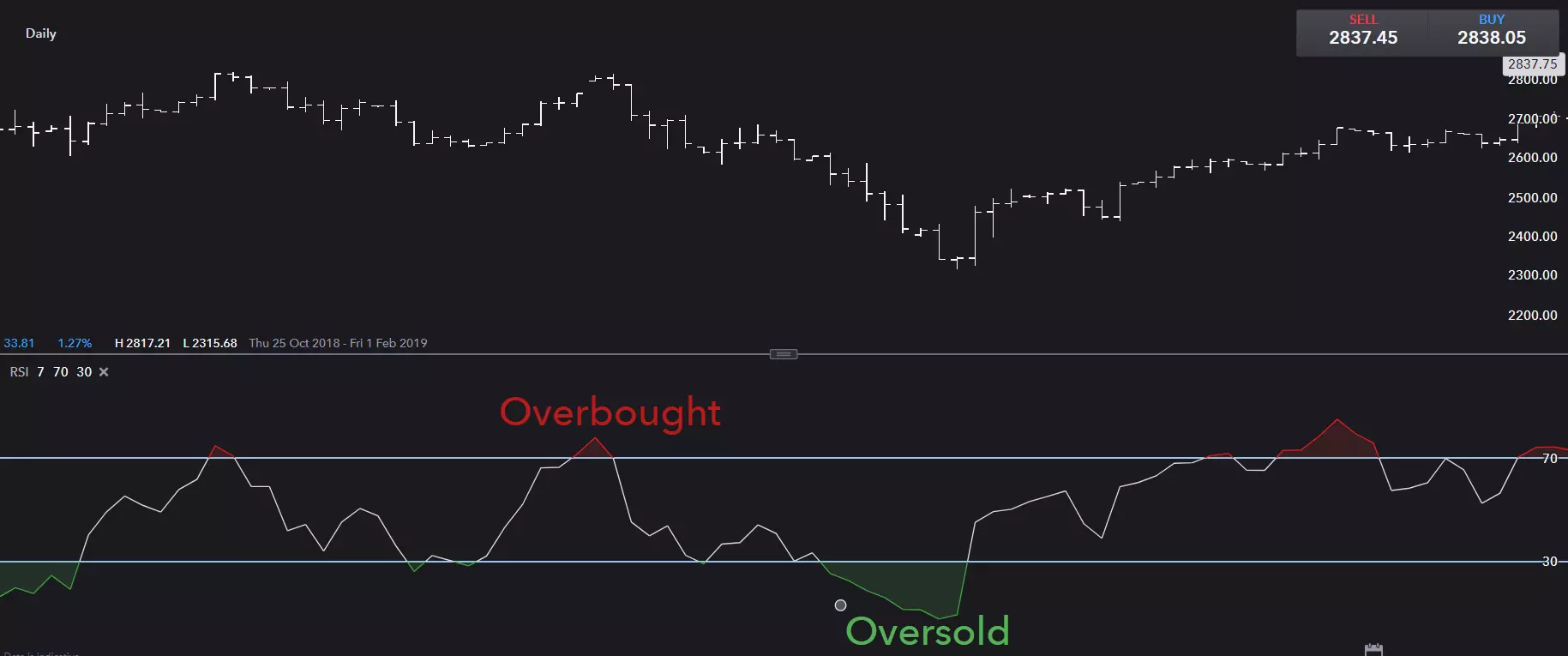A trader's guide to the relative strength index (RSI) indicator

What is the RSI indicator?
The relative strength index, more commonly referred to as the RSI, is a popular indicator used in technical analysis, which falls under the oscillator category. The RSI is primarily used to help traders identify momentum, overbought and oversold market conditions, as well as divergence and hidden divergence signals in financial markets.
How is the RSI calculated?
The RSI indicator value is calculated using the following formula:
- RSI = 100 – 100 / (1 + RS)
Essentially the RSI is a calculation of the profitable price closes relative to unprofitable price closes, reflected as a percentage.
As the indicator value is reflected as a percentage, it will move between 0 and 100.
What is a momentum indicator?
Momentum indicators are generally considered to be technical tools to measure the speed or velocity of market price movements. Essentially, they are a gauge of a shorter-term trend of a security and give us indications of the suggested health and sustainability of these shorter-term movements by generating what is known as 'overbought' and 'oversold' signals.
What is an RSI overbought signal?
As alluded to earlier, the RSI indicator is expressed as a value between 0 and 100. When the indicator reading approaches the upper end of this range ie above 70, the security in question is said to be 'overbought'.
An overbought signal is the suggestion that the short-term gains in a particular market may be reaching a point of maturity, (for the time being) i.e., the rally that took the price higher may be nearing a short-term end and possibly readying for a near-term decline.
What is an RSI oversold signal?
When the RSI indicator value approaches the lower end of the 0 to 100 range, i.e., below 30, the security in question is said to be 'oversold'.
An oversold signal is the suggestion that the short-term declines in a particular market may be reaching a point of maturity, (for the time being) i.e., the decline which took the price lower may be nearing a short-term end and possibly readying for a near-term rebound to follow.

How to trade with RSI
How do I trade an RSI overbought signal?
An overbought signal with the RSI is considered when the indicator crosses back below the 70 level. Traders might consider using these signals one of two ways.
- A trader who is long might consider using the overbought signal as a signal to lock in profit and exit the trade he/she may already be in. Trading long is trading with the view that the market in question will rise and in this circumstance the trader will look to exit that position with a sell.
- A trader who has no open positions might consider using the overbought signal as a signal to enter a new trade 'short'. A short position is trading with the view that the market in question will fall.

How do I trade an RSI oversold signal?
An oversold signal with the RSI is considered when the indicator crosses back above the 30 level. Traders might consider using these signals one of two ways.
- A trader who has no open positions might consider using the oversold signal as a signal to enter a new trade 'long', thereby entering the market with a buy as the expectation is that the price will rise in the near term.
- A trader who has already sold short in the market may consider using the oversold signal as a signal to lock in profit (if the price has fallen) and exit the trade with a buy.

What is RSI divergence?
A divergence signal with the RSI is considered when the highs or lows of the market price are moving in different directions to the highs or lows on the RSI indicator.
Positive/bullish RSI divergence
For a positive divergence, we look at the lows of both the price and the indicator. If the price is making higher lows, and the indicator is making lower lows, a positive or bullish divergence signal is considered. It is preferable to witness this occurrence when the RSI is in oversold territory.

A positive or bullish divergence suggests short-term gains in the securities price to follow. A positive divergence signal in conjunction with an oversold signal is considered by many market technicians to be a more powerful 'buy' signal than an oversold signal in isolation.
Negative/bearish RSI divergence
For a negative divergence, we look at the highs of both the price and the indicator. If the price is making higher highs, and the indicator is making lower highs, a negative or bearish divergence signal is considered. It is preferable to witness this occurrence when the RSI is in overbought territory.

A negative or bearish divergence suggests a short-term decline in the securities price to follow. A negative divergence signal in conjunction with an overbought signal is considered by many market technicians to be a more powerful 'sell' signal than just an overbought signal in isolation.
What is the best RSI trading strategy?
The RSI is a rangebound indicator, moving between 0 and 100. In turn trading both long and short signals using this indicator is considered best when the price is rangebound in nature as well.
Markets do however frequently move in trends. When considering a market that is trending, it is often considered best practice to trade RSI signals that align with the trend for entry and signals against the trend for exits (not as signals to open new positions against the trend).
The below example shows a market that is in an uptrend. Where oversold signals are used to enter long into the market. The overbought signal is used to exit the trade, not open up a new short entry.

The below example shows a market that is in a downtrend. Here overbought signals are used to enter short positions into the market. The oversold signal is used to exit the trade, not open up a new long entry entry.

RSI vs stochastic oscillator: what’s the difference?
The RSI and stochastic are both oscillators in technical analysis terms. While similar in nature, the mathematical formula used to create each indicator differs. Where the RSI is calculating the average gain vs average loss over x periods, the stochastic is calculating the closing price relative to the x period highest high and lowest low.
Where an overbought and oversold reading is considered at levels 70 and 30 for an RSI respectively, the overbought and oversold signals are considered at levels 80 and 20 for the stochastic respectively.
The signals produced by both indicators are similar although not exactly the same. Some traders like to add both indicators to their analysis and wait for signals to align for extra confirmation before making their trading decisions. Other traders may prefer to use one indicator or the other to avoid duplication in their analysis.
Summing up the RSI
- The RSI is an oscillator/momentum indicator
- It can be used to help determine overbought and oversold conditions
- A variance in the highs of the price relative to the highs on the indicator is considered a negative divergence signal
- A variance in the lows of the price relative to the lows of the indicator is considered a positive divergence signal
- The RSI is rangebound in nature and best applied to a rangebound price environment
- In trending environments signals that align with the trend are considered more reliable
- In trending environments signals against the trend are considered better for exits to trades rather than entries
- The stochastic is similar in its application to the RSI, although the mathematical formula from which it is calculated differs
This information has been prepared by tastyfx, a trading name of tastyfx LLC. This material does not contain a record of our trading prices, or an offer of, or solicitation for, a transaction in any financial instrument. You should not treat any opinion expressed in this material as a specific inducement to make any investment or follow any strategy, but only as an expression of opinion. This material does not consider your investment objectives, financial situation or needs and is not intended as recommendations appropriate for you. No representation or warranty is given as to the accuracy or completeness of the above information. tastyfx accepts no responsibility for any use that may be made of these comments and for any consequences that result. See our Summary Conflicts Policy, available on our website.
